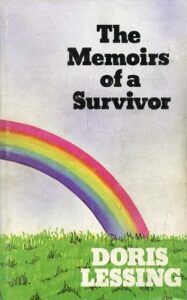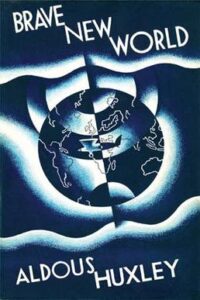
Frances Oliver
 ‘Dystopia’ is a word that only began appearing in dictionaries in 1868. Before that there was only ‘Utopia’ which came into the language with Sir Thomas More’s book of that name, in 1551. ‘Utopia’ meant “an imaginary ideal place, enjoying a perfect, legal, social and political system”.
‘Dystopia’ is a word that only began appearing in dictionaries in 1868. Before that there was only ‘Utopia’ which came into the language with Sir Thomas More’s book of that name, in 1551. ‘Utopia’ meant “an imaginary ideal place, enjoying a perfect, legal, social and political system”.
It is hard to think of any recently written Utopia. Dystopia abounds, inspired by the horrors of modern war and modern tyranny, the inhumanity and alienation of industrial civilization, the fear of nuclear annihilation, the new scientific and psychological techniques for government control – and now of course the ecological catastrophe that looms ever closer with little hope of real action on the warnings which date back half a century!
Much dystopic writing appears in science fiction. Huxley’s Brave New World is probably the most famous example. This was published in 1932 and now seems remarkably prescient; a society of test tube babies, sex for pleasure only, happiness drugs, popular entertainment on tap, and skillfully directed propaganda that keep everyone unquestioning and content with the social status for which he or she was test-tube bred. Huxely’s Brave New World might be said to fit definitions of both Utopia and Dystopia. It is a society that functions perfectly without conflict; but also a society in which all the freedom, variety, mobility, independence of spirit, creativity and thought a previous age treasured have disappeared.
After Huxley, H.G. Wells, E.M. Forster, George Orwell and Ray Bradbury amongst others who also wrote stories of advanced dystopic societies, the atomic age has featured dystopias that regress; in which apocalypse or revolution end present civilization; where humanity, or large parts of it, descend into chaos and anarchy or brutal dictatorship, or both. Walter Miller’s A Canticle for Leibowitz pictures a post-nuclear medieval dark age, in which once again only monasteries are the repositories of faith and learning, and scientific knowledge is lost; but with monks illuminating the atomic blueprints now regarded as mysterious sacred texts, one fears the secrets of the blueprints will eventually be rediscovered and the doomed ‘progress’ of humanity begin again. In Robert Merle’s Malevil we are also in a post-nuclear apocalypse world, with a group of men who, meeting in a historic castle, escaped the blast. They manage to survive but their supplies and crops
must be ruthlessly defended with arms. Eventually they make contact with other castles, battles are won, alliances and relationships made, children born again and in the new Middle Ages there are rays of hope.
Margaret Atwood’s The Handmaid’s Tale and its sequel pictures a grim post new-revolution USA where women are selected for breeding and other roles by a theocratic, tyrannical patriarchy. Most terrifying and powerful of all these dystopic books I found Cormac McCarthy’s unforgettable The Road where civilization has totally collapsed into chaos and anarchy, and murder and cannibalism are rife. A father and his little son journey south where it will be warmer and there are hopes of food. Part of their dangerous and arduous travel is done with the aid of an abandoned supermarket shopping trolley they find, so the collapse is obviously recent and abrupt.
‘South’ is also the destination of migrants in Doris Lessing’s The Memoirs of a Survivor, which she described as “an attempt at autobiography”. Here the origins of catastrophe are unclear, and there are still functioning, but increasingly helpless, authorities. A sort of normal life continues in the big apartment building where the narrator lives, but the streets are dangerous with marauding bands, supplies are less and less and more and more people choose to leave – for the unknown ‘south’. Parts of this book are mystical and surreal; the narrator sometimes walks though a corridor into another dream-like world, from which a young girl is brought out to the everyday world to be in her charge. A vivid and absorbing book; but for me the juxtaposition of dream- and real-world was an uncomfortable and unsatisfactory fit.
In my next article I would like to write about two other dystopias, one recent, John Lanchester’s The Wall, the other, Richard Jefferies’ Wild England, late 19th century, but postulating the same origins – a great geographic change, as we now in fact face with the climate crisis, and a similar setting – a country or a world largely lost underwater.
I would be pleased to hear from readers about other dystopias – or Utopias if any can be imagined – they have found moving or convincing for what the future may hold.


Today I felt like the art world was a Dystopia. Imagine if most artists we know dissembled like Joseph Beuys, and everyone wore the emperor’s new clothes. In “The Destruction of Art”, Dario Gamboni writes of the 1980 sculpture exhibition in Bienne, Switzerland, a city known for high tech steel and space age technology. The typically serious law-abiding Swiss citizens vandalized or destroyed 44 outdoor sculptures out of 177. Gamboni admits the only vandalized works were those made of trash from the town garbage dump, but the trash had been certified as art by experts.[1]
Gamboni was surprised the townspeople couldn’t see that; perhaps these engineers lacked the sophistication to recognize garbage as their highest cultural achievement. Gambino did not ask if proselytized curators tried to impose capricious nonsense on shard-eyed realists. In accepting the urinal we became suspect, for deep down inside we know it is not the fount of wisdom from which we want to drink.
[1] Dario Gamboni, The Destruction of Art: Iconoclasm and Vandalism, p173, Reaktion Books, London, U.K. 1973